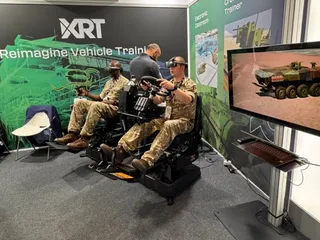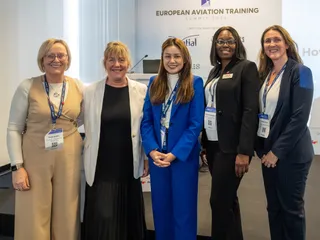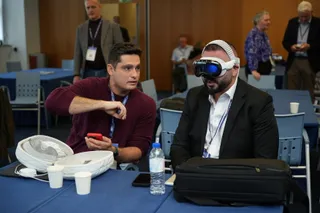Emerging Tech at WATS Highlights XR Shift
Contact Our Team
For more information about how Halldale can add value to your marketing and promotional campaigns or to discuss event exhibitor and sponsorship opportunities, contact our team to find out more
The Americas -
holly.foster@halldale.com
Rest of World -
jeremy@halldale.com

By Shane Klestinski, Team Orlando News-powered by Capital Communications
Senior members of the aviation training community presented findings during the “Emerging Technology” session at the World Aviation Training Summit (WATS) in Orlando, Florida, April 8.
WATS brings together leaders from throughout the airline training community. Its organizer, Halldale Group, describes WATS as “the world’s largest gathering of aviation training professionals, serving airlines, aircraft manufacturers, regulators, training providers and the training industry, designed by and for aviation professionals.”
Shane Carroll, Airbus’ head of training software, facilitated the session. Participants included Dre Fournier, vice president of growth at HTX Labs; Julian Abich, Ph.D., senior human factors engineer with Quantum Improvements Consulting; Maximilian Zweybrücken, Lufthansa Group’s product manager for pilot training, and Gilad Scherpf, senior director of aviation training development, also for Lufthansa Group.
Carroll noted that the technologies discussed were now in their “implementation” phase in the industry, and they were past the “early stages of ideating what they can do.”
Fournier delivered the first presentation, “Leveraging Human Performance Data & AI to Enable Competency Based Training,” which focused on taking this human performance data and integrating it into analytics and real-time usage to develop competency-based training (CBT) and tailor-made instruction. He began his portion by discussing his organization’s first insights from working with the Air Force, which focused on the scalability of extended reality (XR) training. They started developing “a data-driven approach to understanding where each student or trainee is” to merge the proficiency gap between experts and beginners.
“Everyone knows, there are a lot of shortages going on, whether it’s maintainers or pilots,” Fournier said. “There is huge opportunity for us to leverage artificial intelligence (AI) to create pathways to make us faster, more proficient, and use it as a tool – not as a means to replace, but more of an aid to make us better.”
Fournier pointed out that everyone has a different definition of what “CBT” means to them. Of the two different ways his organization has observed to accomplish effective training, one is more a time-based and linear-focused paradigm where the student goes through a pathway without deviation. While that training has its place in certain types of curricula, according Fournier, when competency aspects really gets introduced, trainers can assess hand-tracking, whether an individual is hesitating, and eye-tracking movements in terms of performance-based training and stressors like heart rate or perspiration.
“When you start taking all that data, leveraging it all, and putting it together, you really start to put together a picture of that individual and making training specific to them,” Fournier said. “In some instances, if you do have hesitation in training in a ‘no-fail’ environment, then the likeliness of potential failure becomes a lot higher. Understanding who you’re training is hugely important.”
As Abich began “Overcoming Barriers to XR Adoption,” he clarified that his content was “really applicable to any type of training technology.” He told the story of the “Link Trainer,” an early aviation trainer created in the 1920s that had the dual-use function of being “a device for training, but also an entertainment apparatus.” Jumping to the modern day, Abich drew parallels to current, undergraduate pilot training in the Air Force, which employs some of the same tools used for gaming and entertainment purposes, such as virtual reality headsets.
“It’s really important to understand that technology is not the training, it’s how you utilize the technology,” Abich said. “That comes to how we’re going to overcome [issues] by changing how we think of the utilization of the technology. [It won’t be] from a tech-focused perspective where we’re trying to find, ‘Where does this hammer fit a solution?’ but ‘How does the solution fit around the learning?’”
Abich emphasized that in taking a learning-centric approach, trainers had to build the curriculum around the students and how they learn. He cited research that has shown that active, experiential learning is what most effectively helps acquire and retain knowledge and skills.
“Students progress at different rates, so why hold them back?” Abich said. “It’s not a one-size-fits-all solution. You have to allow individuals to progress at different rates if we want them to meet the [through-put] quotas we’re expecting in terms of pilots.”
Zweybrücken and Scherpf finished the session with their presentation, “VR in Flight Crew Training.” They discussed opportunities (increased immersion, accessibility and training effectiveness), uncertainties (the chances of avoiding negative training and the acceptance of training management), and barriers (such as new processes and adaptation/approval of revised training programs).
“In a trainee-centered approach, the trainee acceptance plays an important role in being successful,” Zweybrücken said. “We’re not just talking about Gen Z pilots, but those who are more experienced by 10, 20 or 30 years. The main goal is to avoid negative training, but we’re also in a highly regulated environment. It’s almost uncharted terrain, not only with implementing the technology, but rather integrating it and incorporating it into a complete training set-up and program to have real added value at the end.”


